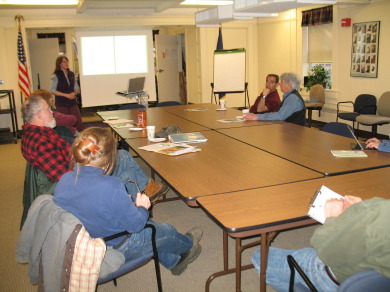 A cool rainy day was well-spent indoors this weekend at the Grafton County UNH Cooperative Extension office for a discussion on grassland-nesting birds, hosted by myself and other experts on the subject as part of my graduate research. My research, a partnership with the Vermont Center for Ecostudies and New Hampshire Audubon, is an extensive outreach program to maximize quality habitat for grassland birds on privately-owned lands.
A cool rainy day was well-spent indoors this weekend at the Grafton County UNH Cooperative Extension office for a discussion on grassland-nesting birds, hosted by myself and other experts on the subject as part of my graduate research. My research, a partnership with the Vermont Center for Ecostudies and New Hampshire Audubon, is an extensive outreach program to maximize quality habitat for grassland birds on privately-owned lands.
Last summer, a team of citizen scientists and I surveyed open fields for grassland birds, including the bubbly Bobolink, throughout the Upper Connecticut River Valley. The survey was a success and now we know more about where these sensitive birds are nesting. The good news is that grassland birds are back on the map, but the bad is they still need immediate conservation action if they are to remain a unique component of the Upper Valley’s heritage.
Conserving grassland birds requires providing habitat for nesting and allowing birds to complete their nesting cycle. Most species build their nests right on the ground, and the idea of waiting to mow fields until August when they are done nesting can be a tough sell to landowners, especially to farmers who need fresh green grass for livestock feed; depending on the type, later cut grasses can be dry, tough and have little nutritional value. Perhaps the most important piece of my project is cultivating trust within the local community and establishing groups who are willing to grow grass and Bobolinks. Since last summer’s survey, I’ve built relationships with some of the owners of the fields we searched and many of them were invited to the meeting on Saturday.
The meeting aimed to create a network of folks in the Upper Valley who could serve as local advisors in grassland bird nesting behavior and conservation. So, if a landowner would like to manage their fields for grassland birds, there will be a neighbor or friend nearby who knows where to start. After a presentation on my project and some training in bird-friendly grassland management practices, the floor was opened to discussion in forming the “ambassador” group.
Great questions and ideas were presented by the attendees, who included retired and active farmers and hayfield owners. The nesting and habitat requirements of American Kestrels was a hot topic, as were federal payment incentive programs for landowners who practice delayed hay cutting.
We decided by the end of our fruitful discussion that VCE could develop an online clearinghouse where ambassadors can communicate with each other, ask questions, and post relevant information about grassland birds. Ambassadors could continue monitoring known breeding bird sites in their areas and help willing landowners enact bird-friendly management. These are the very beginning steps towards maintaining a long-term, open dialogue supporting the success of all kinds of landowners, and maintaining viable populations of grassland birds in the Upper Valley. Let’s keep moving!
– Jamie Sydoriak

Grassland restoration does not just bleong in the Midwest, or what we typically associate with the Prairie States. In Oregon, the state bird, the western meadowlark, is disappearing, because the natural prairies of the Willamette Valley have been converted into farmland. So there is a desperate need for grassland restoration there.